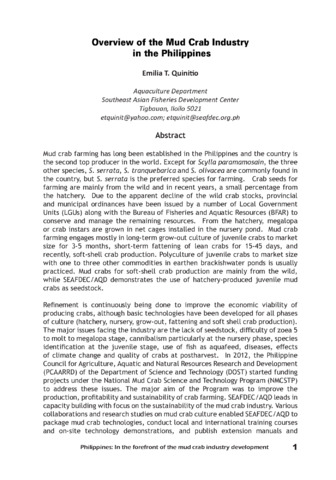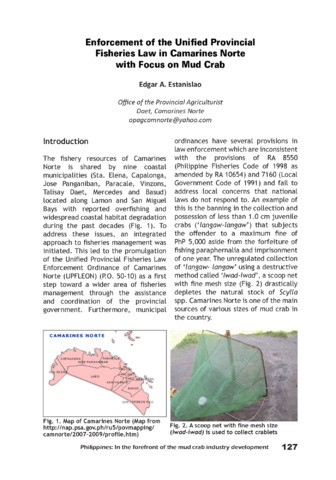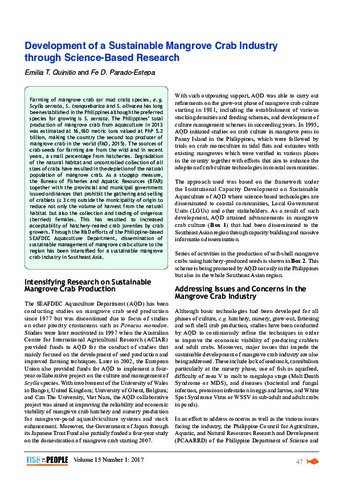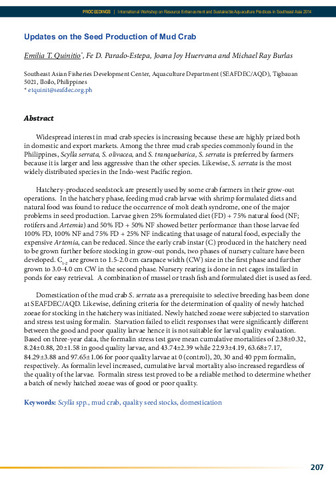Overview of the mud crab industry in the Philippines
Share
Abstract
Mud crab farming has long been established in the Philippines and the country is the second top producer in the world. Except for Scylla paramamosain, the three other species, S. serrata, S. tranquebarica and S. olivacea are commonly found in the country, but S. serrata is the preferred species for farming. Crab seeds for farming are mainly from the wild and in recent years, a small percentage from the hatchery. Due to the apparent decline of the wild crab stocks, provincial and municipal ordinances have been issued by a number of Local Government Units (LGUs) along with the Bureau of Fisheries and Aquatic Resources (BFAR) to conserve and manage the remaining resources. From the hatchery, megalopa or crab instars are grown in net cages installed in the nursery pond. Mud crab farming engages mostly in long-term grow-out culture of juvenile crabs to market size for 3-5 months, short-term fattening of lean crabs for 15-45 days, and recently, soft-shell crab production. Polyculture of juvenile crabs to market size with one to three other commodities in earthen brackishwater ponds is usually practiced. Mud crabs for soft-shell crab production are mainly from the wild, while SEAFDEC/AQD demonstrates the use of hatchery-produced juvenile mud crabs as seedstock.
Refinement is continuously being done to improve the economic viability of producing crabs, although basic technologies have been developed for all phases of culture (hatchery, nursery, grow-out, fattening and soft shell crab production). The major issues facing the industry are the lack of seedstock, difficulty of zoea 5 to molt to megalopa stage, cannibalism particularly at the nursery phase, species identification at the juvenile stage, use of fish as aquafeed, diseases, effects of climate change and quality of crabs at postharvest. In 2012, the Philippine Council for Agriculture, Aquatic and Natural Resources Research and Development (PCAARRD) of the Department of Science and Technology (DOST) started funding projects under the National Mud Crab Science and Technology Program (NMCSTP) to address these issues. The major aim of the Program was to improve the production, profitability and sustainability of crab farming. SEAFDEC/AQD leads in capacity building with focus on the sustainability of the mud crab industry. Various collaborations and research studies on mud crab culture enabled SEAFDEC/AQD to package mud crab technologies, conduct local and international training courses and on-site technology demonstrations, and publish extension manuals and scientific publications since the mid1990s. Research and Development activities have been translated into improved production. With the recent developments and refinements of technologies, it is expected that the Philippines will increase its production by 25-50% in the next 5 years.
Suggested Citation
Quinitio, E. T. (2017). Overview of the mud crab industry in the Philippines. In E. T. Quinitio, F. D. Parado-Estepa, & R. M. Coloso (Eds.), Philippines : In the forefront of the mud crab industry development : proceedings of the 1st National Mud Crab Congress, 16-18 November 2015, Iloilo City, Philippines (pp. 1-12). Tigbauan, Iloilo, Philippines: Aquaculture Department, Southeast Asian Fisheries Development Center.
Subject
aquaculture regulations  ; commercial species
; commercial species  ; crab culture
; crab culture  ; Fishery industry; fishery institutions
; Fishery industry; fishery institutions  ; fishery management
; fishery management  ; marine crustaceans
; marine crustaceans  ; polyculture (aquaculture)
; polyculture (aquaculture)  ; pond culture
; pond culture  ; research programmes
; research programmes  ; seed (aquaculture)
; seed (aquaculture)  ; seeding (aquaculture)
; seeding (aquaculture)  ; seed collection
; seed collection  ; sustainability
; sustainability  ; training
; training  ; Scylla olivacea; Scylla paramamosain; Scylla serrata; Scylla tranquebarica; Philippines; hatcheries
; Scylla olivacea; Scylla paramamosain; Scylla serrata; Scylla tranquebarica; Philippines; hatcheries 
 ; commercial species
; commercial species  ; crab culture
; crab culture  ; Fishery industry; fishery institutions
; Fishery industry; fishery institutions  ; fishery management
; fishery management  ; marine crustaceans
; marine crustaceans  ; polyculture (aquaculture)
; polyculture (aquaculture)  ; pond culture
; pond culture  ; research programmes
; research programmes  ; seed (aquaculture)
; seed (aquaculture)  ; seeding (aquaculture)
; seeding (aquaculture)  ; seed collection
; seed collection  ; sustainability
; sustainability  ; training
; training  ; Scylla olivacea; Scylla paramamosain; Scylla serrata; Scylla tranquebarica; Philippines; hatcheries
; Scylla olivacea; Scylla paramamosain; Scylla serrata; Scylla tranquebarica; Philippines; hatcheries 
Taxonomic term
Related items
Showing items related by title, author, creator and subject.
-
Unified provincial fisheries law enforcement of ordinance of Camarines Norte focusing on mud crab
Estanislao, Edgar A. (Aquaculture Department, Southeast Asian Fisheries Development Center, 2017)Due to overfishing and widespread coastal habitat degradation, the Province of Camarines Norte passed a provincial fisheries law enforcement known as the Unified Provincial Fisheries Law Enforcement Ordinance of Camarines ... -
Development of a sustainable mangrove crab industry through science-based research
Quinitio, Emilia T.; Parado-Estepa, Fe D. (Secretariat, Southeast Asian Fisheries Development Center, 2017)Farming of mangrove crab (or mud crab) species, e.g. Scylla serrata, S. tranquebarica and S. olivacea has long been established in the Philippines although the preferred species for growing is S. serrata. The Philippines’ ... -
Updates on the seed production of mud crab
Quinitio, Emilia T.; Parado-Estepa, Fe D.; Huervana, Joana Joy; Burlas, Michael Ray (Aquaculture Department, Southeast Asian Fisheries Development Center, 2015)Widespread interest in mud crab species is increasing because these are highly prized both in domestic and export markets. Among the three mud crab species commonly found in the Philippines, Scylla serrata, S. olivacea, ...





